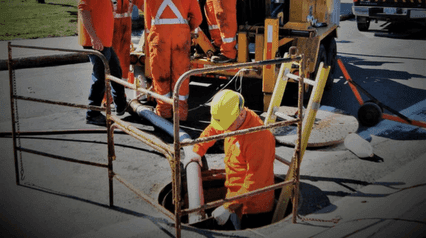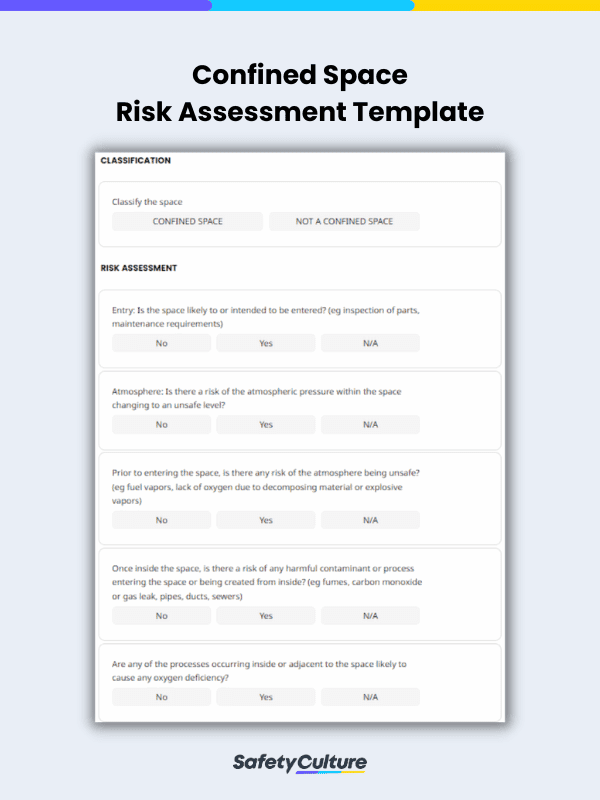What is Confined Space Risk Assessment?
Confined space risk assessment is a systematic process that ensures proper safety and evacuation procedures are followed and necessary permits are acquired when working in confined spaces. When conducting a confined space risk assessment, templates and safety checklists are used to check and record atmosphere testing, adequate ventilation, PPE usage, staff signatures, and permit documentation.
What 3 Things Make a Confined Space?
An area must meet all these three specific criteria to be called a confined space:
1. Area has limited openings for entry and exit
It can be difficult to enter a confined space and perform general maintenance or other work activities. This makes rescue or escapes challenging in case something goes wrong while a worker is inside the space. Areas with limited entry and exit points, even if there are several, can still be considered confined spaces.
2. Area is just enough for a worker to enter and conduct work
If a worker cannot comfortably fit his or her body in the space, there is a high possibility that the worker will be trapped inside. Ensure first that the confined space can fit a person before commencing work in said area.
3. Area is not intended for continuous human occupancy
Confined spaces are not designed to hold a person, especially for extended periods. It can also mean that an area is intended to contain something else other than people—examples of this are spaces such as vessels, furnaces, and tanks.
What are the Types of Confined Space?
The term “confined space” is a broad term that covers a variety of spaces. There may be several confined spaces in your workplaces, depending on the type of business. There are confined spaces that present immediate health hazards or endanger a worker’s life upon entry. On the other hand, some provide less immediate dangers and may present little chances of causing a worker harm.
Essentially, confined spaces fall in either of these two categories—the extremely hazardous ones and the less hazardous. Dangerous confined spaces are known as permit confined spaces because they require appropriate permits, which can only be obtained after a qualified person has completed a confined space risk assessment of the specific area. The less dangerous confined spaces are referred to as non-permit confined spaces.
A permit confined space is one that has one or more of the following characteristics:
- It contains or could contain a hazardous atmosphere, such as those from toxic fumes or gases.
- It contains material that could engulf the person inside, such as grains in a silo or water in a tank.
- It has an inwardly converging wall or a floor that slopes downward and tapers to a small cross-section.
- It has any other recognized safety hazard that can cause serious, immediate harm.
A non-permit confined space does not or could not contain hazards that could cause serious harm or death. Entering a non-permit space does not require the completion of a confined space risk assessment. Common non-permit spaces include equipment closets, drop ceilings, ventilated tunnels, and machinery cabinets.
What are the Main Dangers in a Confined Space?
Confined spaces are hazardous by nature due to the limited space and entry/exit points; such conditions increase the chances of a worker getting trapped inside. However, confined space hazards and precautions must always be assessed since there are other dangers associated with working in a confined space.
- Oxygen deficiency
There can be a lack of sufficient oxygen in confined spaces due to displacement of air by another gas, absorption of air onto steel surfaces, or various biological processes or chemical reactions. - Toxic atmosphere
A toxic atmosphere is dangerous because it can cause a variety of acute effects, including impaired judgment, unconsciousness, or death. A toxic atmosphere may be present in a confined space due to the following:- The presence of a fire or flames
- Formation during or due to the work done in the space
- Seepage from improperly isolated adjoining facilities
- Disturbance of sludge and other deposits
- Gases released from under scale and within brickwork resulting from the work process
- Remnants of previous storage or processing
- Oxygen enrichment
Increased oxygen levels are not ideal, especially in the presence of combustible materials because it can increase the risk of fire and explosion. Materials or substances that don’t burn in air may burn in an atmosphere with enriched oxygen. - Flammable or explosive atmospheres
Flammable atmospheres can result from the presence of flammable gases or liquids or a suspension of combustible dust in a confined space. Igniting a flammable atmosphere leads to an expulsion of hot gases that can cause the disintegration of a structure. - Excessive heat
Due to the enclosed nature of confined spaces, the risk of heat stroke is increased, especially in extremely hot or humid conditions. Lack of ventilation and the wearing of PPE can exacerbate these conditions so extreme care is required whenever entering or working in a confined space. - Flowing liquid or free-flowing solids
Liquids or solids that flow into the confined space can drown, suffocate, burn, or cause other injuries to a worker.
How can you Reduce the Risks Associated with Working in a Confined Space?
Conditions in a confined space are most often extremely hazardous and life threatening. This is why industries that require working in confined spaces are obligated to complete confined space risk assessments to avoid serious consequences such as injuries, accidents, or worse, fatalities. Results of the risk assessment can help you provide the necessary precautions and safety measures.
Below are 5 safety suggestions that can help in mitigating risks associated with working in confined spaces:
Safe System of Work
According to the Occupational Safety and Health Branch Labour Department, “A safe system is a formal procedure which results from systematic examination of a task in order to identify all the hazards. It defines safe methods to ensure that hazards are eliminated or risks minimised.”
Safe system of work has five steps, which are:
- Assess the task
- Identify the hazards
- Define safe methods
- Implement the system
- Monitor the system
It’s steps are seemingly similar to a risk assessment, however, it is important to note that a risk assessment is not equivalent to a safe system of work. Thus, a risk assessment validates whether a safe work system is required. A site-specific risk assessment must be completed first to consider all foreseeable hazards associated with a task and the risks associated. Then, the safe system of work incorporates all that information to define a detailed step-by-step method of carrying out the task safely. A site specific method statement should be provided as a result, to help employees adhere to the safety methods of performing the tasks associated with working in confined spaces.
Ventilation
Setting up a proper ventilation system for confined spaces is an effective method to control heat and atmospheric hazards found in confined spaces. Before entering a confined space, air quality testing should be carried out and continuous monitoring should be maintained to ensure that atmospheric conditions are safe before entry.
In some cases, natural ventilation will not be as reliable and sufficient as it can also be unpredictable. Therefore, mechanical ventilation systems such as blowers and fans are recommended for use to maintain air quality.
PPE
Personal Protective Equipment or PPE are workers’ first line of defense when things go wrong on site. Employees working in confined spaces should wear proper PPE, this includes:
- head, hand and foot protection
- eye and hearing protection
- waterproof and thermal clothing
- respirators and breathing apparatus
- safety harnesses
Emergency Protocols
No matter how careful you are or how correctly you follow procedures when working in confined spaces, there will always be that possibility of an emergency arising. While emergency protocols may not directly eliminate the risks of working in a confined space, it does help in:
- preventing fatalities and injuries;
- reducing structural and equipment damages;
- protecting the environment and community; and
- accelerating the resumption of operations.
So, before any work starts, ensure that there are emergency arrangements in place. Emergency arrangements to prepare will depend on the risks, but should include the following:
- Communications – Communication tools should be readily available to enable people from inside the confined space to contact emergency services.
- Rescue and resuscitation equipment – Suitable rescue and resuscitation equipment should be provided for use by rescuers, and they should be correctly trained to operate such equipment.
- Capabilities of rescuers – There should be personnel who are properly trained, sufficiently fit to carry out task, and capable of using equipment for rescue (e.g., winches, retrieval devices, breathing apparatus, lifelines and firefighting equipment.)
- Shutdown – A shutdown protocol may be necessary before attempting emergency rescue operations.
- First-aid procedures – There should be a complete first-aid equipment present and the assigned first-aider must be properly trained and holds a valid first aid training certificate.
- Local emergency services – Determine response capabilities with the authority, how they will be made aware of an incident, and at what information regarding the particular dangers in confined spaces should be given to them upon arrival.
Training
Training is the most critical when working with confined spaces. All employees working in confined spaces should be given proper training to carry out their tasks. Their training should also include being made aware of emergency procedures.
Confined Space Assessment Tool
Ensure workers are safe in confined spaces through early identification of potential risks and safety issues using SafetyCulture (formerly iAuditor), a powerful inspection app that you can use on any mobile device. Sign up for a free account with iAuditor and enjoy the following benefits:
- Digitize paper forms through the Smartscan feature and customize them using the drag-and-drop template editor.
- Easily take, annotate, and attach photos to inspections for more accurate reports.
- Conduct inspections anytime, anywhere—even while offline.
- Access inspection data whenever and wherever you need them by saving them in the cloud.
- Auto-generate detailed reports immediately after an inspection.
FAQs About Confined Space Risk Assessment
A confined space risk assessment should be comprehensive to help easily identify potential hazards and eliminate them. Assessments should include a check of the following:
- oxygen levels
- entry and exit points
- atmospheric pressure
- oxygen deficiency
- lighting sufficiency
- electrical hazards
- emergency assessment
Confined space risk examples include pipelines, tanks, vessels, storage bins, manholes, vaults, tunnels, furnaces, and attic spaces. Enclosed areas and other work equipment/machine housings that have limited entry and exit points can be considered confined spaces.
The Communications Worker of America (CWA) believes that there should be at least two workers present during confined space operations. This is to ensure that while one worker performs the job, another one is on top of things and on the lookout for potential safety issues. Regulations for this, however, still vary according to specific local requirements.



